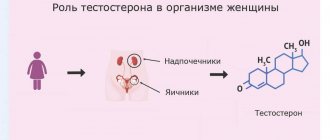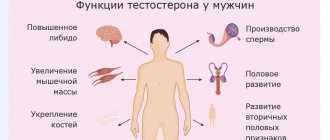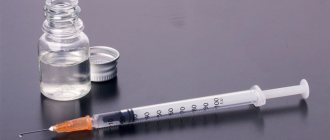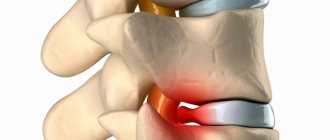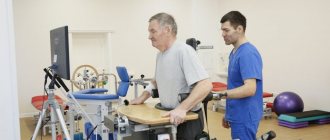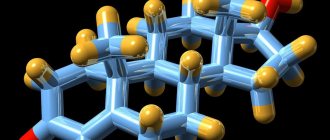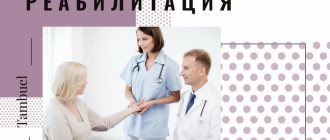Hypogonadism
Blackheads (acne)
Cervical cancer
18518 October 16
IMPORTANT!
The information in this section cannot be used for self-diagnosis and self-treatment.
In case of pain or other exacerbation of the disease, diagnostic tests should be prescribed only by the attending physician. To make a diagnosis and properly prescribe treatment, you should contact your doctor. We remind you that independent interpretation of the results is unacceptable; the information below is for reference only.
Testosterone: indications for use, rules for preparing for the test, interpretation of results and normal indicators.
The role of testosterone in a woman's body
Many people believe that testosterone is produced only in the male body. In fact, this is not at all the case and the hormone is found in a certain amount normally in the body of women, performing a number of functions. Why is it needed and what is the role of testosterone in a woman’s body?
Among the main functions and hormones in the female body are:
- Helps maintain normal muscle development
- helps strengthen bone tissue
- helps strengthen teeth
- supports sexual activity and is aimed at reproduction
- takes part in the development of hair follicles, controls the growth of body hair
- controls the functioning of the nervous system
- regulates the production of adipose tissue and maintains its level in the body
- participates in the metabolic process
- regulates water-salt metabolism
- prevents the development of diseases of the circulatory system
- Helps the body resist stress.
Useful vitamins and various sports supplements
Proper nutrition allows the body to effectively synthesize testosterone in the body. And the presence of modern technologies allows us to do this even more efficiently. In other words, proper nutrition must be supplemented with special high-quality supplements. Among the most effective and affordable of them are:
- D3. It is not a vitamin supplement, but a hormone that our body receives from regular sunlight. If a woman is not lucky enough to live in sunny, warm regions, if her work is carried out in an office, supplementing with this vitamin would be the best option.
- Omega-3. High-quality fish oil consumed every day promotes effective hormone production.
- Special whey protein. This is a supplement that is optimal not only for men, but also for women. With this supplement you can get the required amount of protein for health. This substance allows you to restore, protect and build the muscles necessary for the body.
- Caffeine. Numerous studies have shown that drinking 100 mg of regular caffeine before going to the gym helps increase the production of the necessary hormone.
Good nutrition and optimal physical activity should be accompanied by adequate sleep.
Scientists have proven that testosterone synthesis occurs exclusively when a person is sleeping. If you are chronically sleep deprived, if you sleep less than 5 hours a day for a long time, the body simply will not have time to produce the much-needed hormone. In addition to the production of testosterone, adequate sleep and rest also reduces the amount of cortisol, which tends to block testosterone.
To ensure yourself a good night's rest, you should protect yourself from your smartphone and from taking special invigorating drinks in the evening. All you need to do is take a warm, relaxing bath or shower.
Reasons for increased testosterone in the female body
The hormone testosterone in women is increased: the reasons for this can be very diverse, but the main place among them is given to:
- hormonal disorders in the body;
- taking certain medications;
- unbalanced and unhealthy diet of women;
- vegetarian lifestyle - absence of meat and fish in the diet;
- presence of a tumor in the body;
- heredity;
- pregnancy status;
- menopause;
- ovulation.
Drug treatment
If testosterone is significantly reduced, experts prescribe conservative treatment for women. The standard treatment regimen includes drugs that contain artificial or natural testosterone.
Modern medicines come in different forms. You can take regular tablets, give injections, or use special patches or gels. Among the most popular tablet drugs are:
- Andriol is a medicine that is made on the basis of special testosterone undecanoate;
- Methyltestosterone.
A very popular drug for injection is Testosterone Propionate. As for the transdermal method, we can mention the Androderm patch. It is glued directly to the surface of the skin - on the back, thigh or abdominal area. You can purchase Androgel gel and apply it to your stomach or shoulders two to three times a day.
Hormone replacement therapy is characterized by the presence of a large number of contraindications. For this reason, it should be carried out exclusively under the supervision of an experienced, qualified physician and strictly after a thorough examination. As soon as the specialist is convinced that there are no chronic pathologies, he will prescribe appropriate medications and monitor their use.
How does increased testosterone manifest in women?
A high level of testosterone in a woman’s blood can be diagnosed not only by the results of laboratory tests of women’s blood, but also by certain symptoms. High testosterone in women: symptoms can be very varied, but the presence of at least one of them is a reason for additional tests.
Excess testosterone in women - the symptoms are very diverse and specific:
- hormonal imbalance and menstrual irregularities such as hypomenorrhea (scanty periods) or amenorrhea (complete cessation of menstruation)
- increased growth of body hair in places where previously no vegetation was observed, and the hair becomes coarse
- poor skin condition – the skin becomes dry, flaky or greasy
- there is a change in mood, the woman is irritable, nervous, aggressive, her sleep is disturbed, and sometimes depression is observed
- the figure becomes similar to a male body type
- increased sexual arousal
- the woman's voice becomes rough, similar to a man's
- activity and physical strength in women with high levels of testosterone in the blood increases
- polycystic changes in the ovaries.
If you have one or several symptoms at once, it is recommended to immediately consult a specialist and donate blood to check the level of the hormone in the blood.
What are hormones?
The content of the article
A hormone is a chemical substance. It is secreted by one tissue and travels with body fluids to affect other tissues of the body. Essentially, hormones are “chemical messengers.” Many hormones, especially those that affect growth and behavior, are important for both men and women.
The amounts and levels of hormones change daily. The sex hormones, estrogen and testosterone, are secreted in short bursts—pulses—that vary from hour to hour and even minute to minute.
The release of the hormone varies between night and daytime and from one stage of the menstrual cycle to the next.
Do estrogen levels drop during menopause?
Yes. Estrogen levels drop during menopause. This is a natural condition for all women between the ages of 40 and 55. Also, a decrease in estrogen levels can occur suddenly in young women who have had their ovaries removed, leading to what is called surgical menopause.
Perimenopause is the transition period before menopause. At this stage, the first natural decline in estrogen levels and other physiological changes begin. Women going through perimenopause may experience weight gain along with other menopausal symptoms. For example, they may have irregular periods, hot flashes, and vaginal dryness.
On average, menopause occurs at age 51. When this happens, a woman's body produces less estrogen and progesterone. Declining estrogen levels during menopause can cause unpleasant symptoms, including:
- tides;
- night sweats;
- vaginal dryness or itching;
- loss of libido or sex drive.
Some women begin to act up. This may or may not be related to estrogen loss. Lower estrogen levels may also increase the risk of heart disease, stroke, and osteoporosis.
Sources
- Kasprian G., Langs G., Cortes MS. Fetal MRI-based artificial intelligence in gestational age prediction—a practical solution to an unsolved problem? // Eur Radiol - 2021 - Vol - NNULL - p.; PMID:33885957
- Hanly P., Ortega-Ortega M., Sharp L. Friction Costs and the Chain of Vacancies Problem: A Novel Vacancy Multiplier Solution. // Value Health - 2021 - Vol24 - N4 - p.548-555; PMID:33840433
- Dell'Osso LF. Two Electrical Engineers, One Problem, and Evolution Produced the Same Solution: A Historical Note. // J Eye Mov Res - 2021 - Vol14 - N1 - p.; PMID:33828817
- Verbruggen S., Gessulat S., Gabriels R., Matsaroki A., Van de Voorde H., Kuster B., Degroeve S., Martens L., Van Criekinge W., Wilhelm M., Menschaert G. Spectral prediction features as a solution for the search space size problem in proteogenomics. // Mol Cell Proteomics - 2021 - Vol - NNULL - p.100076; PMID:33823297
- Caballero-Morales SO. Solution strategy based on Gaussian mixture models and dispersion reduction for the capacitated centered clustering problem. // PeerJ Comput Sci - 2021 - Vol7 - NNULL - p.e332; PMID:33816985
- Pillay K., Perumal S. Intraoperative Cell Saving: Is the Solution to the Actual Problem? // J Extra Corpor Technol - 2021 - Vol53 - N1 - p.62-67; PMID:33814608
- Fernández-Real X., Ros-Oton X. Free Boundary Regularity for Almost Every Solution to the Signorini Problem. // Arch Ration Mech Anal - 2021 - Vol240 - N1 - p.419-466; PMID:33785965
- Miller EB., Murphy RB., Sindhikara D., Borrelli KW., Grisewood MJ., Ranalli F., Dixon SL., Jerome S., Boyles NA., Day T., Ghanakota P., Mondal S., Rafi SB ., Troast DM., Abel R., Friesner RA. Reliable and Accurate Solution to the Induced Fit Docking Problem for Protein-Ligand Binding. // J Chem Theory Comput - 2021 - Vol17 - N4 - p.2630-2639; PMID:33779166
- Serrano-Bueno G., Sánchez de Medina Hernández V., Valverde F. Photoperiodic Signaling and Senescence, an Ancient Solution to a Modern Problem? // Front Plant Sci - 2021 - Vol12 - NNULL - p.634393; PMID:33777070
- Kania A., Sarapata K., Gucwa M., Wójcik-Augustyn A. Optimal Solution to the Torsional Coefficient Fitting Problem in Force Field Parametrization. // J Phys Chem A - 2021 - Vol125 - N12 - p.2673-2681; PMID:33759532
References
- Dedov, I. I. Endocrinology: textbook / 2nd ed., revised. and additional - M.: GEOTAR-Media, 2013. - 432 p. — ISBN: 978-5-9704-2535-1.
- Kronberg, M. Reproductive endocrinology: textbook. - M.: GEOTAR-Media, 2011. - 416 p. — ISBN: 978-5-91713-029-3, 978-1-4160-2911-3.
- Tkachuk, V. A. Introduction to molecular endocrinology. Reception and intracellular signaling / ed. V. A. Tkachuk - M.: GEOTAR-Media, 2021. - 240 p. — ISBN 978-5-9704-4264-7.
- Khera, M. Testosterone Therapies, 2021. - Vol. 43(2). — P. 185-193. doi: 10.1016/j.ucl.2016.01.004.
Physical activity
To activate blood circulation and increase testosterone levels, it is recommended to do:
- race walking;
- bodybuilding;
- athletics;
- swimming.
The loads should be intense and constant, at least 3 times every 7 days. Sets (2-3) must be alternated with a short rest (1-2 minutes). With such physical activity, excess fat will disappear and muscles will grow.
In order not to reduce testosterone, during sports there should not be:
- fatigue;
- loss of strength;
- lethargy;
- pain.
